- Регистрация
- 17 Февраль 2018
- Сообщения
- 24 572
- Лучшие ответы
- 0
- Баллы
- 2 093
Offline

Expert's Rating
Pros
- Mixed reality is great fun
- Big step up in graphics quality
- Much cheaper than the Apple Vision Pro
- Not many mixed reality titles… yet
- Not as affordable as the Quest 2
- Video passthrough could be better
With night-and-day graphics upgrades and the addition of mixed reality, the Quest 3 justifies its higher price. There’s enough here to even recommend that Quest 2 owners upgrade.
Best Prices Today: Meta Quest 3
Retailer
Price

$499.00
View Deal
Price comparison from over 24,000 stores worldwide
Product
Price
Price comparison from Backmarket
If you somehow missed the announcement of Apple’s Vision Pro earlier this year you might not be aware of the drive towards mixed reality. For the uninitiated, it’s basically another name for augmented reality, which means the addition of virtual elements atop your normal surroundings.
That could be anything from a virtual screen playing a video to a pot plant in the corner of the room. It really doesn’t matter: The important part is that you can see both your real environment as well as elements of a virtual one at the same time.
It’s funny, because mixed reality isn’t even remotely new. Microsoft rolled out Windows Mixed Reality six years ago and there have been a bunch of mixed reality VR headsets you could hook up to a suitably beefy PC or laptop.
The Meta Quest 3 might sound like a mere evolution of the Quest and Quest 2, but it isn’t. It’s a proper game-changer because it supports mixed reality.
Where the Quest 2 and original Quest had low-resolution monochrome cameras that offered a grainy, monochrome representation of your room, the Quest 3’s much higher-resolution color cameras produce an almost lifelike representation where you can walk around and interact with things just as if you weren’t wearing the headset.
Almost. It isn’t perfect: There’s too much video wobble unless you stand still, which can make you feel queasy. Plus, quality quickly becomes grainy when the room isn’t bright enough. You really need a lot of light for video passthrough to look its best.
And while the main components of the Quest 3 are slimmer, they’re still pretty heavy and the headset gets uncomfortable after a while. You need the headband to be tight to keep the lenses from moving around on your head and I really disliked the pressure on my cheekbones. Having tried out the optional silicone facial interface along with the Elite strap, I’d recommend making both upgrades if you find the standard Quest 3 uncomfortable.
Fortunately, the jump in graphics quality alongside mixed reality is plenty to offset the Quest 3’s downsides, and they go a long way to justifying the price hike over the Quest 2.
Meta Quest 3 features and design
- Adjustable depth
- IPD wheel
- Optional Elite strap
The most obvious change from the Quest 2 is the three pill-shaped protrusions on the front of the Quest 3. These house the cameras and a depth sensor, which are used for mixed reality.

Jim Martin / Foundry
But the front of the device is also 40 percent slimmer, which Meta says improves the weight balance on your head. The fabric strap has been slightly redesigned, too, with a y-shaped piece at the back.
It’s still too large for people with small heads, and the center strap still doesn’t have enough adjustment to cater to those of diminutive proportions.
However, it’s fine if you have a normal or large head and you can replace the strap with either Meta’s own Elite one or an aftermarket one if you really can’t get on with it.
My main complaint is that it’s too difficult to adjust the precise fit once it’s on, which is exactly what the Elite strap addresses with its dial.

Jim Martin / Foundry
As an aside, the orange and blue straps and “facial interfaces” you see in some of the photos are accessories: You cannot choose these when you buy a Quest 3.
The good news is that the IPD wheel is back. That means you can adjust the inter-pupillary distance while wearing the Quest 3 and it goes from 53-75mm. Officially, that is. The actual range is 58-70mm, as shown on the on-screen display.
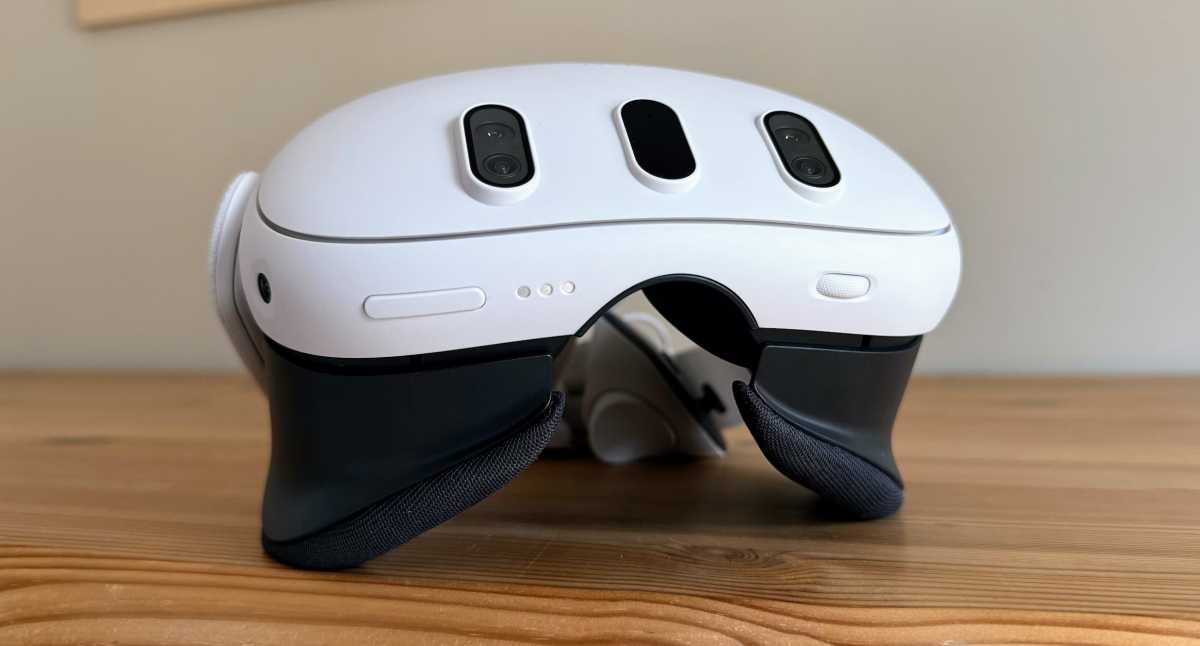
Jim Martin / Foundry
Meta says the 58mm setting works for people with IPD from 53-63mm and the 70mm for those with pupils 65-75mm apart. The range seemed to be fine for everyone who had a play with the Quest 3 that Meta sent for review, too.
As a glasses wearer, I particularly appreciate the ability to adjust the distance of the lenses from your face, with no need to fit a special insert, then remove it when someone else is using the headset. Buttons on either side allow four different settings: They’re a bit fiddly to adjust, and must be done one at a time.
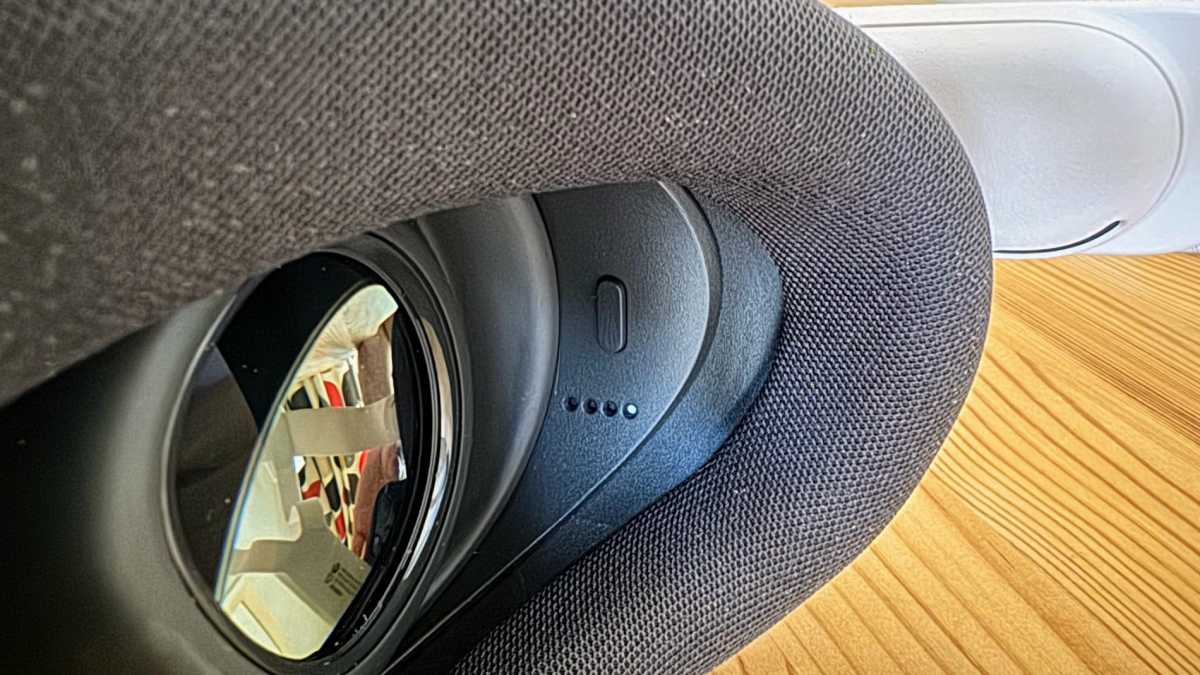
Jim Martin / Foundry
Speakers are built into the strap and they’re fine. Not great, just fine. Because they’re not actual headphones you can still hear what’s going on around you: great in some situations, but it ruins the immersion in others. There’s not much bass, either, but spatial audio still works well.
The good news is that there’s still a 3.5mm output for connecting your own headphones if you do demand better quality and total immersion.
You can also pair Bluetooth headphones, but make sure you use some VR-specific ones to avoid an audio delay that could similarly ruin the experience.
The final physical control is a volume rocker on the underside of the headset at the front.
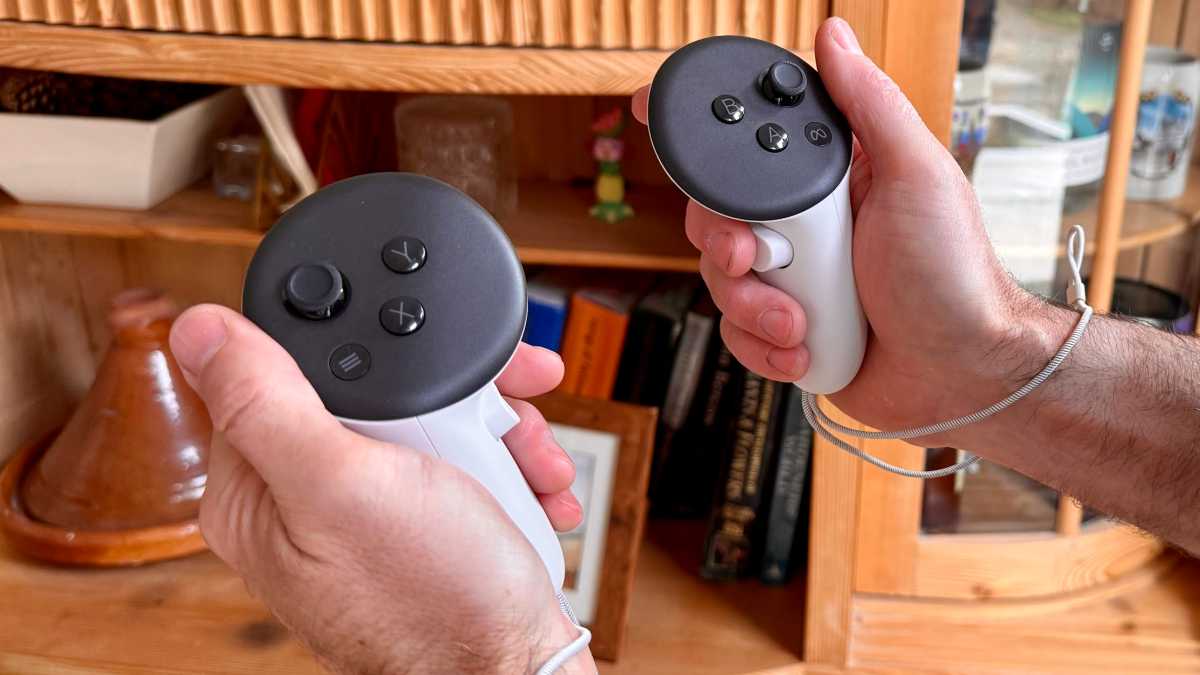
Jim Martin / Foundry
The Quest 3’s controllers are more compact than before on account of not having tracking rings at the top. The headset can still track the controllers, of course, but the real benefit is that they don’t bash into each other when you cross your hands over or bring them close together.
They’re each powered by a single AA battery: It’s a shame Meta hasn’t made them rechargeable. You can upgrade to the Quest Touch Pro controllers which are rechargeable, among other benefits, but the battery life is quite a lot shorter than the regular Quest 3 controllers.
If you prefer, you can ditch the controllers entirely and let the Quest 3 track your hands. This works best in a brightly lit room where there’s plenty of contrast between your hands and the walls / floor.
Hand tracking is improved with the Quest 3 so you can now interact with things with fingers. Of course, this requires the app, game, or whatever you’re doing to support that. It takes a little while to get used to controlling things with your hands, but it feels quite natural after that.
The Quest 3 makes a massive leap in terms of graphics quality.
Once you’ve enabled hand tracking in the settings, you gently tap the controllers together twice to switch into hand tracking mode. Using just your hands, you can bring up a quick-action menu by touching your thumb and forefinger, swipe lists of icons around, and select things by prodding them or by pinching your thumb and finger together for controls too far away to “touch.”
Meta is improving the speed of hand tracking so it isn’t far behind the controllers, allowing you to play more fast-paced games without lag. Plenty of titles don’t support hand tracking, sadly, so you still need to use controllers for favourites such as Beat Saber as well as newer ones like Les Mills Body Combat.
Some titles, such as Xponential+, are exclusively hand tracked. This workout app works in mixed reality so you can see your living room, say, and place the instructor wherever you want in the room.
Another handy feature is the ability to double tap on the side of the headband to switch between full virtual reality and passthrough. This means you don’t have to take off the Quest 3 if you need a break, or someone needs your attention briefly.
Room scanning
Yet another feature, enabled by the Quest 3’s depth sensor, is the ability to automatically scan your room and detect the walls and furniture. You simply look around until the scan is “good to go,” at which point mixed-reality apps understand what’s where, so zombies can climb through your windows in The Cabin, and monsters can hide behind your sofa.
This all takes less than a minute, but it’s frustrating the Quest can’t store multiple rooms. If you move to a new one, the old one is deleted. That’s a real pain if you go the extra mile and manually draw around each table, sofa, and shelving unit to get the most accurate mixed reality. Hopefully this is something Meta will address in a future update.
The other problem is that it only works well in rectangular rooms with flat ceilings. Many are, but if yours isn’t, as some of mine aren’t, then it ruins the immersion when monsters burst in through a non-existent ceiling or wall.
How does the Quest 3 perform?
The Quest 3 makes a massive leap in terms of graphics quality. If it’s your first VR headset, you won’t appreciate just how much of an improvement it is. Although resolution isn’t quite 30 percent better than the Quest 2, everything is noticeably sharper and text is much easier to read.
And if you’re coming from the original Quest, it’s a completely different league. Where details were fuzzy and indistinct, they’re clear and precise in the Quest 3. Again, there’s an element where developers need to optimize their apps and games for the new headset, but much of the time it’s an automatic improvement so games you might already own such as Beat Saber simply look better on a Quest 3.
Each eye sees a resolution of 2064×2208, up from 1832×1900 in the Quest 2. The original Quest had a per-eye resolution of 1440×1600, and was limited to a 72Hz refresh rate. The Quest 3 goes up to 120Hz, although as with the Quest 2, that’s still currently in the “experimental” phase and requires apps to support it.

Jim Martin / Foundry
Resolution and refresh rate are only a tiny part of the story, too. With a field-of-view around 15 percent wider than the Quest 2, Meta’s latest headset lets you see more of your surroundings. It feels more natural and I barely ever noticed that my peripheral vision was restricted, something that happened fairly frequently on the original Quest (and original Oculus Rift).
Arguably more important than this is Qualcomm’s Snapdragon XR2 Gen 2 processor, the other major upgrade in the Quest 3. It packs a new GPU with twice the performance of the Quest 2’s GPU. It should be obvious that higher-resolution screens and higher refresh rates need more processing power, but that isn’t all the extra grunt is useful for.
It’s also needed for the full-color, high-resolution passthrough video that provides mixed reality, but crucially it also enables much better quality graphics.

Jim Martin / Foundry
In specially prepared demos, I was able to press a button on the controller to switch between the Quest 3’s visuals and an emulation of the Quest 2. Reader, the difference was night and day.
To put it simply, the Quest 3’s graphics quality makes objects on the Quest 2 look flat and unrealistic. They’re much more detailed with dynamic lighting and shadows, much improved texture quality and more. These upgrades make a big difference in “enhanced” titles such as Red Matter 2.
Quest 3’s graphics quality makes objects on the Quest 2 look flat and unrealistic.
Developers don’t need to do anything for the Quest 3 to render their apps at its higher resolution, but they do need to update them to take advantage of things like dynamic lighting.
Although there’s only 2GB more RAM than in the Quest 2, this doesn’t seem to be a limitation for the Quest 3, at least in the games and apps I tried out. Loading times were generally acceptable, with the vast majority being just a few seconds.
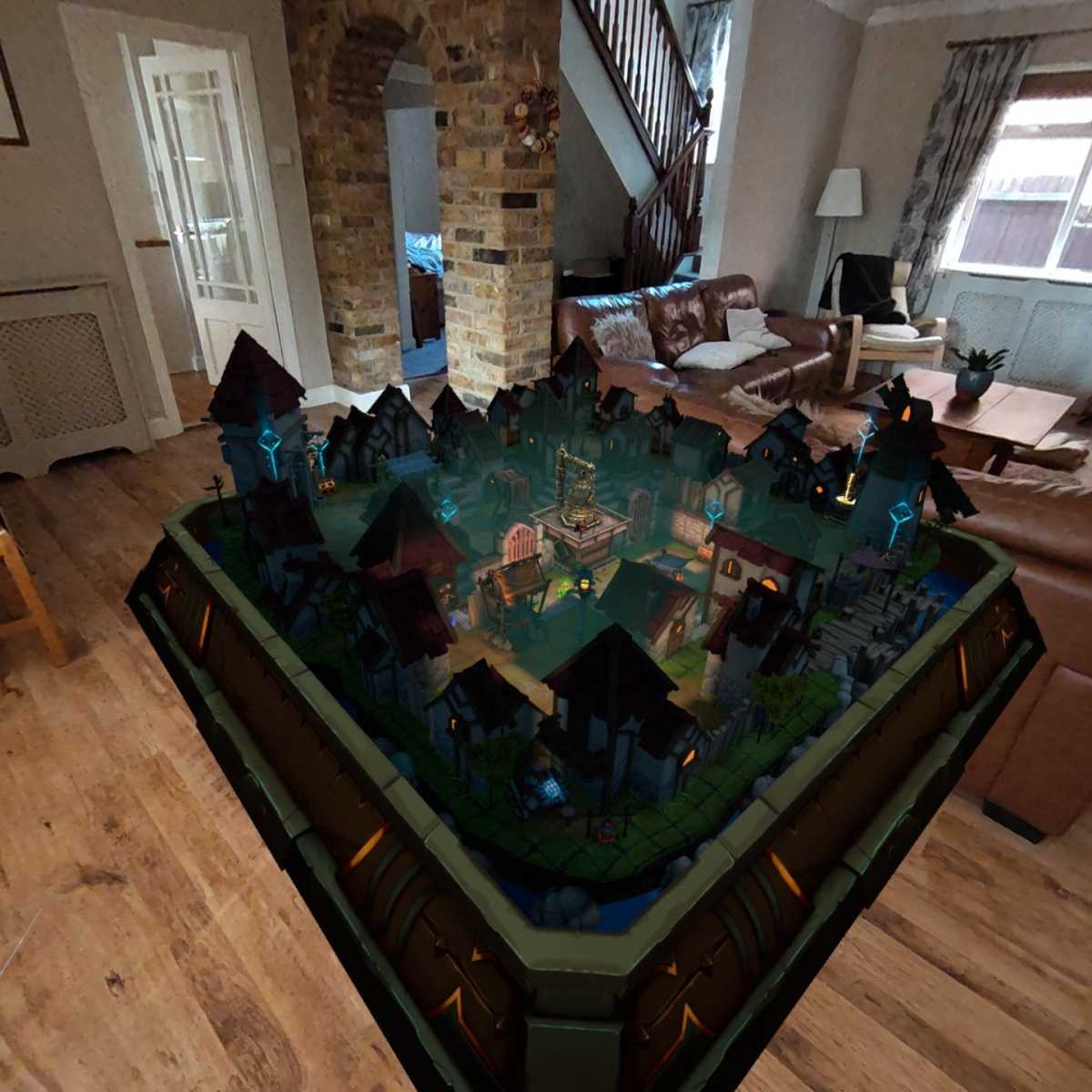
Jim Martin / Foundry
Right now, there aren’t very many mixed reality games. Meta promised 50 at launch, but that seems optimistic: There certainly weren’t anywhere near 50 in the store the day before the headset’s release. Some of them are Quest Pro apps for business use, which won’t appeal to consumers.
Right now, there aren’t very many mixed reality games.
It’s likely to be a chicken-and-egg situation where devs are waiting until the hardware is in people’s hands before spending money updating existing titles for mixed reality, or creating new ones. Either that, or they’re just late. It doesn’t matter much: The fact is, there are only a handful of games (including demos like First Encounters) that support MR.
Comfort and battery life
It’s worth addressing one of VR’s biggest problems: comfort. I’ve already talked about the physical aspect, but there’s also the fact VR causes some people to feel sick.
The Quest 3 doesn’t really change anything here: The issue is the disconnect between what your eyes are seeing and what your body feels. That’s why it’s a terrible idea to choose a rollercoaster app or video for your first experience.
Apps and games are marked in the store so you know if they’re “comfortable” or not. With mixed-reality apps, the comfort level is generally much better because you can see the room you’re in, which doesn’t move or shift position.
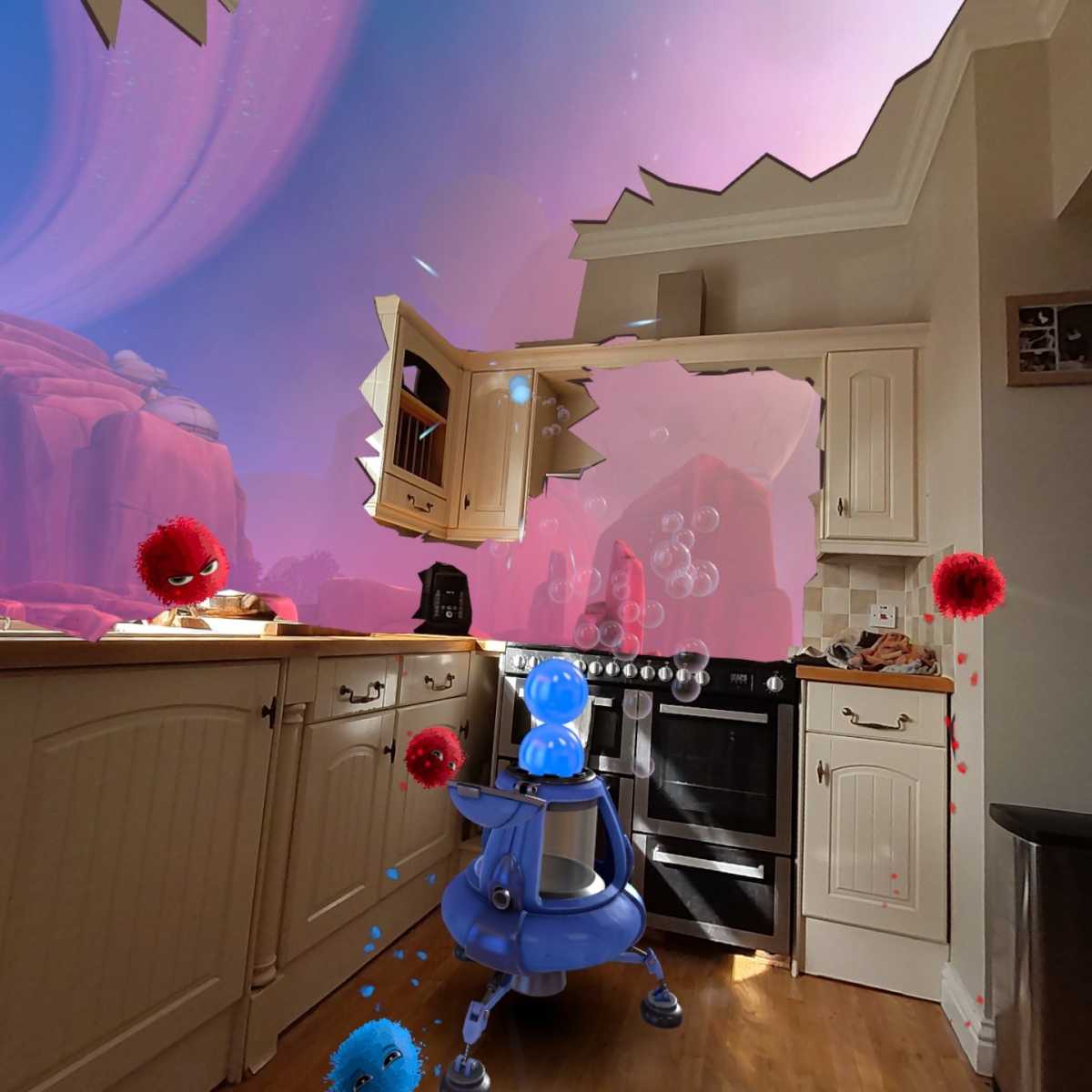
Jim Martin / Foundry
You can move around in it — brilliant in the First Encounters demo above — without feeling nauseous. The problem, as mentioned earlier, is the quality of passthrough video. It’s impressive that everything is in the “right” place: You can pick up your coffee and drink it and avoid furniture just as you would if you weren’t wearing a headset.
The trouble is that the video does sometimes jerk and stutter, as well as bend, warp, and wobble. It’s worse if there are objects close and far away from the cameras in your line of sight. For example, if you’re in a room where a door is open and you can see into another room, objects far away can wobble and bend.
It might be only for a second or even a fraction of a second but it’s enough to make you feel queasy. My advice is to avoid walking around your home and stay in one place, preferably in a room with the doors closed.
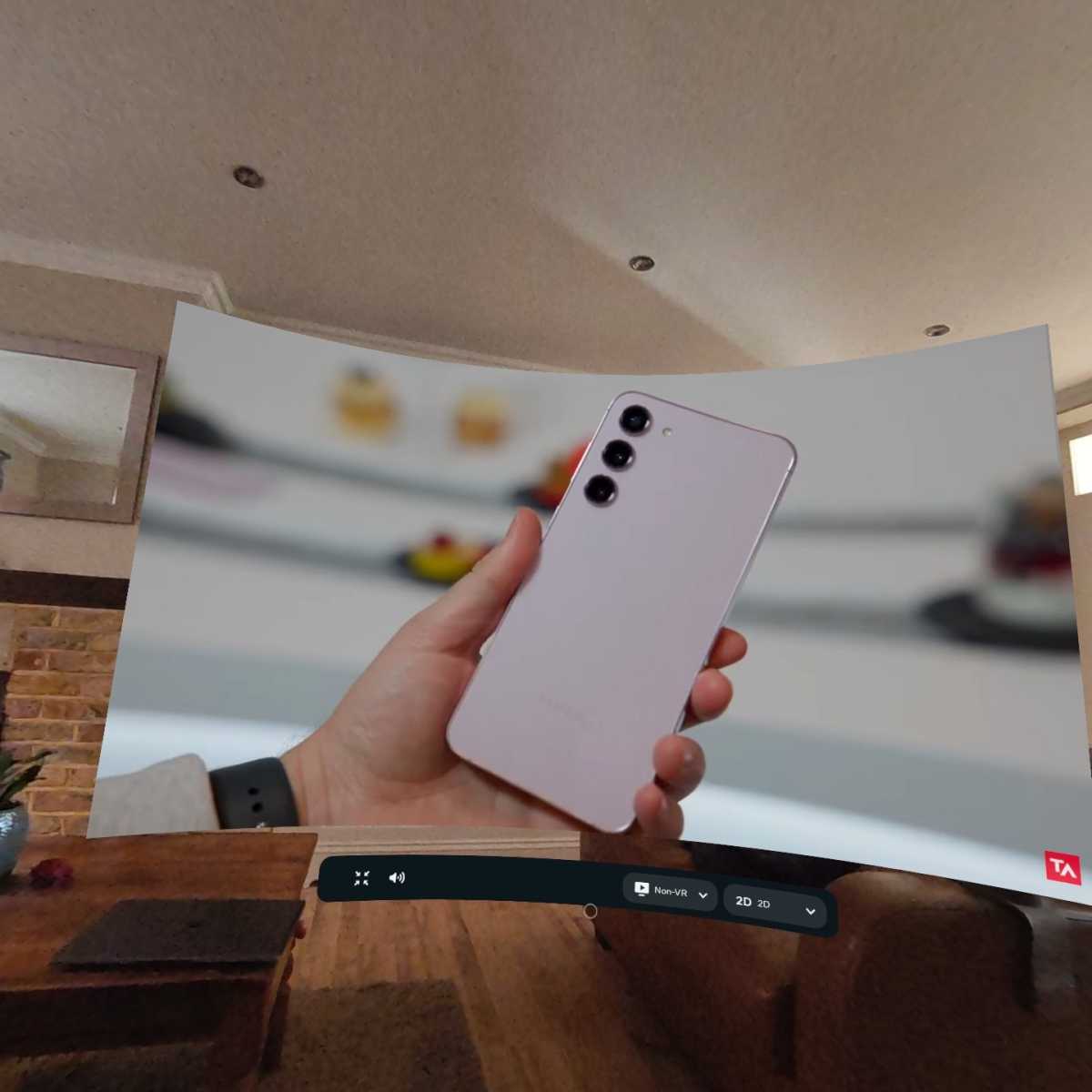
Jim Martin / Foundry
If you want to watch videos in mixed reality you’ll need either an app that supports it or to use the built-in browser and head to a website such as YouTube. I found the Netflix app hadn’t been updated for the Quest 3, and was still showing the Quest 2 controllers, although this was pre-launch. Hopefully Netflix will update it to support MR.
The improved resolution makes it much more enjoyable to watch videos: In “full-screen” mode, they appear as a massive curved display in front of you. I wouldn’t watch a movie because the Quest 3 just isn’t comfortable enough.
Battery life should be good enough for most movies though, at around 2.5 hours. Exact battery life will vary depending upon what you’re doing with the headset, but I found it was in line with Meta’s claims.
An 18W USB-C charger is included in the box, but it’s hardly fast charging, taking around two hours from empty to 100 percent.
Price and availability
As you probably know only too well, the Quest 3 costs $499 / £479. If history is anything to go by, don’t expect to find any significant discounts even a year down the line. You can buy it from Meta, as well as other retailers. Here’s where to buy a Quest 3 in the US and UK.
This means it’s $200 / £179 more than a Quest 2. That’s a big difference, but it’s certainly worth it.
Most people should be okay with the base 128GB model as that’s enough for plenty of games to be installed at the same time. Most VR games are a couple of GB at most, so it’s probably not worth paying $649 /£619 to have 512GB.
Should you buy the Meta Quest 3?
 . The Quest 3 is one of the easiest devices to recommend, even if you already have a Quest 2. I would say there’s at least the same leap in quality between the Quest 2 and Quest 3 as there was between Quest 1 and Quest 2.
. The Quest 3 is one of the easiest devices to recommend, even if you already have a Quest 2. I would say there’s at least the same leap in quality between the Quest 2 and Quest 3 as there was between Quest 1 and Quest 2.Sure, there’s still room for improvement. In a perfect world, the Quest 3 would be lighter, more comfortable to wear for long periods, and last even longer between charges. The other criticism, and almost certainly something that Meta will improve on the Quest 4, is the resolution and quality of passthrough video. It’s good, but not stunningly lifelike.
Similarly, and I’ve deliberately left this until the very end, there’s the absence of eye tracking. That’s something found on the Quest Pro, Apple’s Vision Pro, and PSVR2. It isn’t a feature of the Quest 3 for a number of reasons, but the real question is: Does it matter? As far as I’m concerned, it’s a non-issue.
The Vision Pro uses eye tracking for control and interaction, but it’s understandable that the much cheaper Quest 3 relies on controllers and hand tracking instead.
The other main use is for foveated rendering: making only the portion of the image you’re looking at look really good and rendering less detail in other areas. However, as I’ve already said, I’ve no complaints about the Quest 3’s graphics quality.
Ultimately, it’s still early days for VR and mixed reality and even the Quest 3 is a long way from how good this tech will become. Right now, with current technology being what it is, the Quest 3 is still pretty remarkable for the money. If you can afford it, you should buy one right now.
This review originally appeared on techadvisor.com.
Virtual Reality, Wearable Fitness Devices
